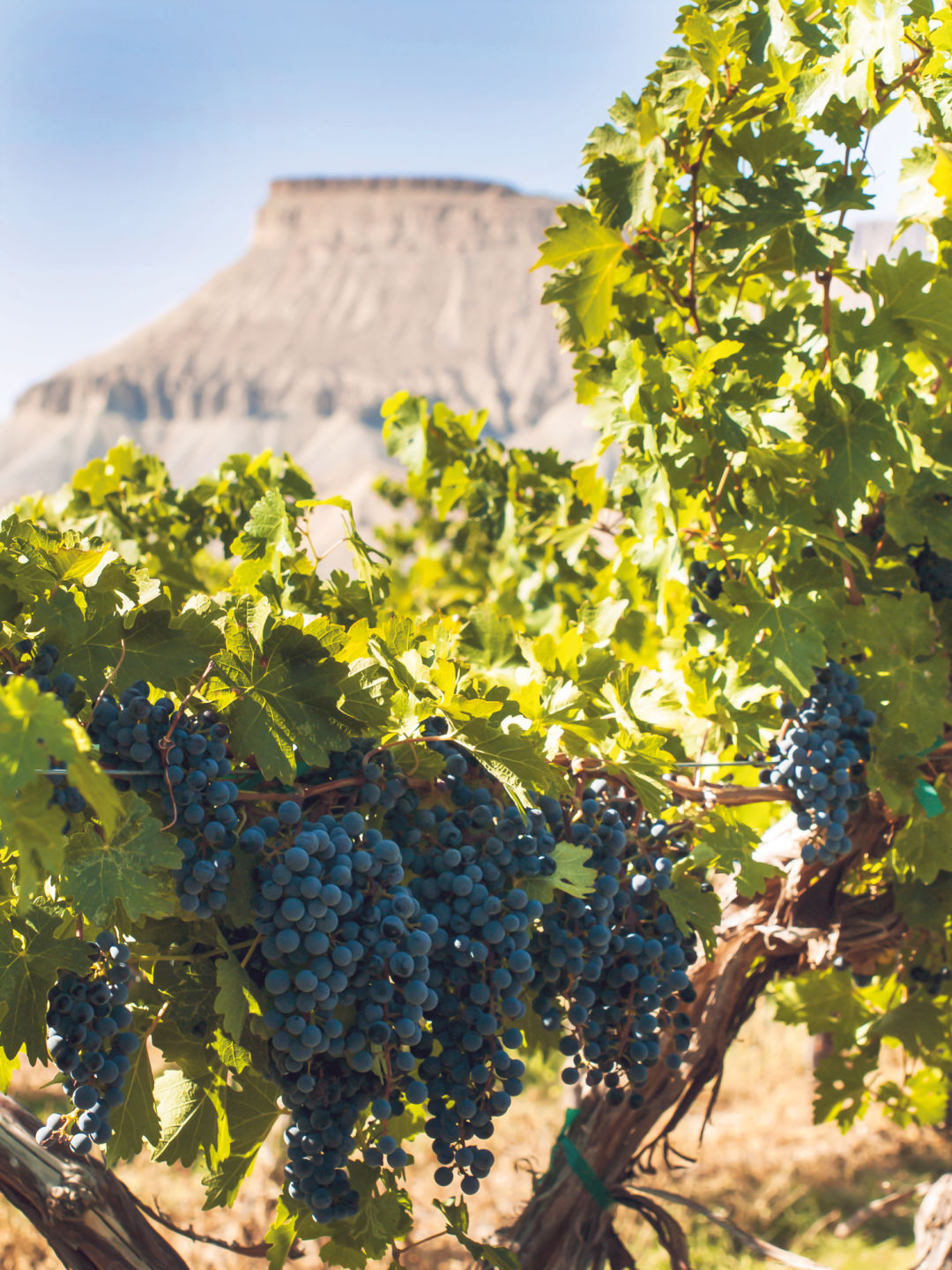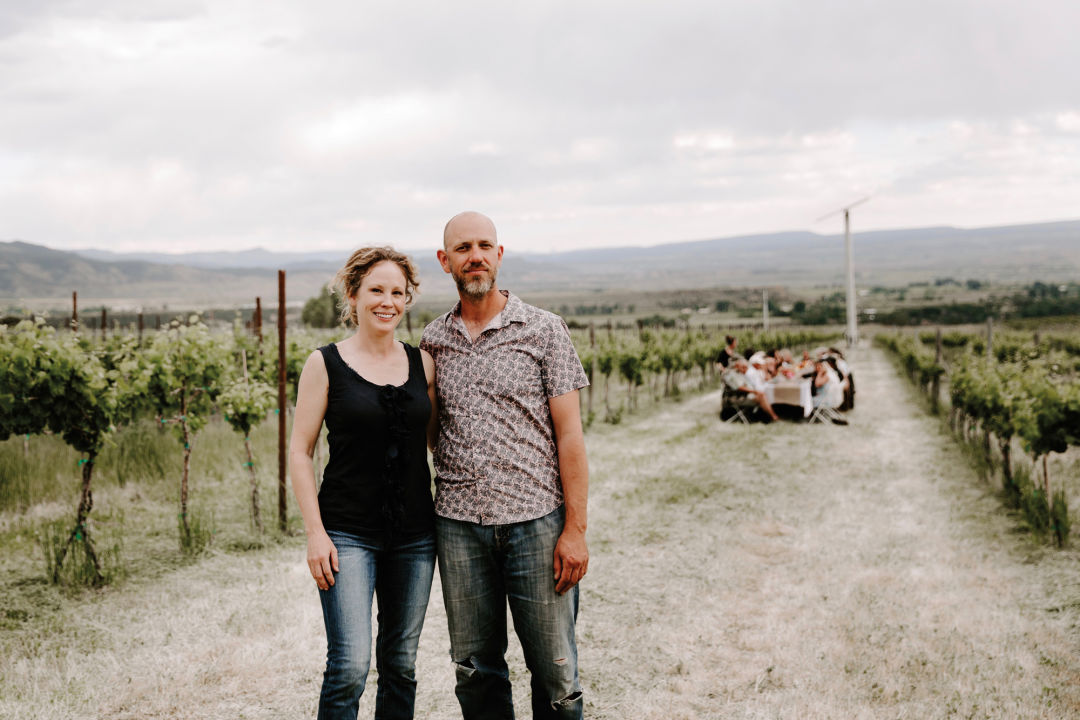Colorado as a Hot Wine Destination?

Most of Colorado’s wine grapes are grown in the Grand Valley.
Imagine you’re at an outdoor wine festival. The sun shines brightly, towering cottonwoods provide shade, and a river meanders through the grounds. Dozens of winemakers pour everything from rich cabernet franc to crisp chardonnay for a sold-out crowd of 6,600 happy patrons. Is this Festival Napa Valley? The Oregon Wine Experience? Perhaps even the Food & Wine Classic at Aspen?
Nope. You’re at Colorado Mountain Winefest’s Festival in the Park in Palisade, next to Grand Junction.
There are plenty of good reasons for even Aspen Food & Wine veterans to head the two hours west to Riverbend Park. As I discovered last September, Winefest is refreshingly laid-back, and—unlike at the Aspen event—the 65-some producers of wine, cider, and sake sell their bottles on-site as well as serve up samples. Live music plays, and picnicking on the grass is definitely encouraged. No one wears high heels, either—if they did, it’d be because Chaco and Jimmy Choo had a love child. Perhaps the best reason to go, however, is to take a deep dive into our state’s burgeoning wine scene.
“It’s an exciting time for wine in Colorado,” says Chris Dunaway, wine director at The Little Nell. Not only does our state now have some 170 wineries, but wine-centric tourism has grown—last year’s Winefest, for example, drew oenophiles from 46 states and nine countries, say organizers—and tasting rooms have popped up in places like downtown Denver and elsewhere along the Front Range. Much of the action centers on Palisade and the surrounding Grand Valley, where more than 85 percent of the state’s grapes are grown, as well as the West Elks area, which includes Paonia and Hotchkiss. But wineries can now be found everywhere from the Four Corners to the eastern plains.
Short of a field trip down I-70 to Winefest, a great place to start tasting Colorado wines is at the Nell, where the renowned list includes a dozen local bottlings. While the cellar features such veteran producers as Sutcliffe Vineyards, west of Cortez in McElmo Canyon, and Jack Rabbit Hill from Hotchkiss, some newcomers get attention as well.
“I’m a big fan of Buckel Family Wine,” says Dunaway of the two-year-old vineyard near Gunnison. “Joe Buckel’s Flyer cabernet blend, chardonnay, and sauvignon blanc are extremely praiseworthy, and I love the work he has done with Cinsault, a traditional southern Rhône grape that’s found a home here in our drier climate. He also makes a beautiful rosé and incredibly interesting reds.”
Some other newer wineries have recently grabbed the national spotlight. Monkshood Cellars (also available at the Nell) may be based in funky little Minturn, but owner Nathan Littlejohn made his reputation at Napa Valley’s legendary Mayacamas Vineyards. So highly regarded is Littlejohn that Monkshood was featured in a special dinner last summer at Boulder’s Frasca Food and Wine.
Then there’s The Storm Cellar in Hotchkiss, which garnered a visit from Wall Street Journal wine columnist Lettie Teague last fall. She called the winery’s 2018 dry Riesling a “lithe, mineral white aged in stainless steel that offers a snapshot of the high-quality wines that [the owners] produce.”
“Storm Cellar is crushing the Colorado Riesling game,” says Clara Klein, lead sommelier at Denver wine bar Sunday Vinyl. “Their two rosés are both noteworthy as well.” She also calls out the Syrah from Paonia’s under-the-radar producer Qutori, along with Palisade and Boulder’s Bookcliff Vineyards—“our most adventurous estate”—for its cabernet franc.

Jayme Henderson and Steve Steese of The Storm Cellar in Hotchkiss.
“Storm Cellar is crushing the Colorado Riesling game.”
–Clara Klein, Denver sommelier
In fact, says Cassidee Shull, executive director of the Colorado Association for Viticulture and Enology, “Cabernet franc is now considered ‘Colorado’s grape.’” The red varietal thrives in the state’s dry, high-elevation climate and often sandy soils. “We’re also seeing new things, such as sparkling wines and wine made from hybrid grapes,” adds Shull.
If there’s a cloud in these chardonnay skies, it’s that Colorado wines don’t seem to get much love locally beyond The Little Nell. Most Roaring Fork Valley wine shops and restaurants have limited, if any, selections. A couple of notable exceptions: Sopris Liquor and Wine in Carbondale carries several shelves of Colorado reds and whites (including Buckel), and in Glenwood, the Pullman restaurant’s wine guru, Bill Bentley, has been a perennial champion of Colorado bottlings.
Back at Winefest last fall, however, a shortage of vintages to taste is not an issue. A crisply chilled white blend from Palisade’s Carlson Vineyards called NSFW—which includes the hybrid grape Vidal blanc—slides down easily with a Greek salad and chicken souvlaki from one of the nearby food trucks. Festivalgoers, some wearing T-shirts with sayings like “A meal without wine is called breakfast,” sprawl out on blankets and folding chairs. A breeze stirs off the river. It isn’t Napa. It’s Colorado, and it is sublime.
TASTING NOTES
For more info
on Colorado wineries and tasting rooms, visit coloradowine.com.
this year’s colorado Mountain Winefest
has been canceled due to Covid-19. Next year’s fest is scheduled to take place September 16–19, 2021.
Helping Hands: During the pandemic, more than 40 Colorado wineries have partnered with the Colorado Restaurant Association’s Angel Relief Fund, which provides financial aid for restaurant employees and food and beverage hospitality workers. For a list of winery participants, go here.













































